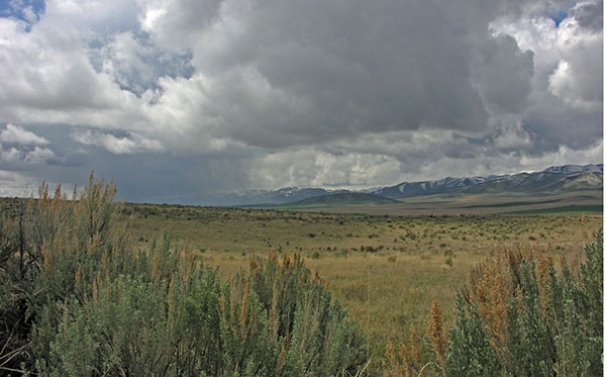Spring is coming slowly to southeast Idaho. After a warm and dry March and early April, the weather has turned cool and rainy.
I took this photo today on CRP land in lonely Arbon Valley. Those are the Deep Creek Mountains.
Several of the big valleys of southern Idaho have more CRP (conservation reserve program) land than just about anywhere else in the United States. As you can see, sagebrush is invading the former wheat field. That is a happy sight to see.
As a sidenote: Arbon Valley suffered severely during the Dust Bowl days of the 1930s.

Comments
I am looking for information about volunteers that camp out with livestock to discourage wolf interaction. Can you point me in the general direction of who to read on this issue? I know that some universities are having grad students participate but I can’t who is running the show in this.
I love your work. You have created a wonderful home for ideas and information. What an amazing resource!
Kris
Indeed, the farm/ranch lands of south-central and -eastern Idaho boast several thousand of the 800,000+ CRP acres in Idaho. I’ve had the great pleasure this spring, as the south zone archaeologist for the Sawtooth National Forest, to walk the landscapes of these “big valleys” that border the Forest, including Juniper Valley, Rafter River Valley, and Junction Valley. Although land use in these areas are far from functioning properly as a balance between biological integrity and the legitimate “traditional lifeways” of ranching/farming communities, the CRP has been a giant step in that direction.
Kris:
I thought this was a good idea two years ago and I spent the summer on a grazing allotment where livestock and wolves interacted. I volunteered to help the rancher, the Beales out of Pomeroy Washington, keep the wolves and livestock apart.
A fat lot of good it did. The woman was irrational, coming out to greet me one day threatening me out of the blue. I later found out it was because she lost a cow to wolves. This was the same woman whom I heard say that she desperately wanted the wolves to kill a particular cow so they could be paid to replace it.
The idea of volunteers camping with livestock to prevent depredation ONLY works if the ranchers are willing to cooperate. There are a few who do not wish to cooperate. And why should they? If Defenders of Wildlife will pay them for their cows lost to wolves – this actually saves them money; for the cows are compensated for at finished market prices. So those cows the Beales lost to the Chesimia pack while I was there, didn’t have to be taken off the range, nor sent to the finishing lot at a cost of $700 or so per cow. Yet they were paid the full value of the cows, some $2000 by my best estimate.
But you really want to know what ticked me off about this? I witnessed the rancher driving her cattle to the area where the wolves were denned and active, rather than keeping them on the grasses that were away from wolves, and coincidentally appeared to me to be more productive for livestock!
Defenders of Wildlife, to my knowledge, is still offering to compensate the Beales, despite my writing to them to tell them of what I witnessed.
Out of all of that, I proposed an experiment: reduce or eliminate compensation to ranchers who lose cattle and are thought to be encouraging losses, such as the Beales did, then monitor losses to see if the go down.
I would LOVE to see this experiment conducted, but the politics of the only organization who could pull it off, Defenders of Wildlife, are such that I could never encourage them to do this. After all, I’m a “troublemaker.”
I wish you luck Kris.
I was up in Yellowstone NP on opening day…saw the same…the day started sunny and clear…then gradually turned cloudy and snowy as the day nearly ended. I attempted to see Sawtoothe ranges at Stanley the day before, that day also was cloudy all day…a beautiful drive non-the-less (my first venture into the area). The next day, I headed home via Driggs and Jackson…sunny, cloudy, and snowy…followed US89 to Salt Lake City. All in all, a great extended weekend for me.
Addendum: On another note, please inform me about fencing around what looked like elm (white bark trees) in Yellowstone NP. I noticed them when traveling along the road near Lamar river. Any answers?
Aspen Trees in an area some call the exclosure. I seem to recall they were part on experiment years ago to see what the Elk were doing to the Quakies in the area. Others, including Ralph, can expand or reject that theory.
Mike,
I would love to hear more about your experience. Would that work? I’m not sure about the etiquette of this blog.
Kris
I can be reached at mwolf[at]wolveswolveswolves{dot}org.
I may go ahead and write up the story about that experience…who knows.
Thanks for the interest.